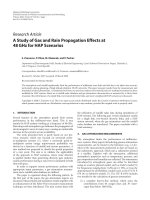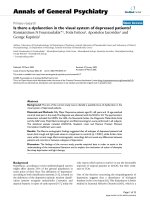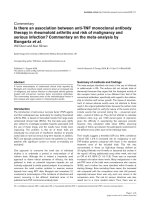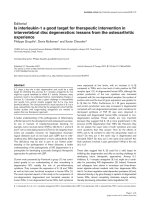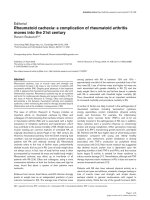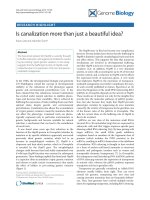Báo cáo y học: "Is Phytalgic® a goldmine for osteoarthritis patients or is there something fishy about this nutraceutical? A summary of findings and risk-of-bias assessment" pot
Bạn đang xem bản rút gọn của tài liệu. Xem và tải ngay bản đầy đủ của tài liệu tại đây (146.93 KB, 3 trang )
Given the modest results of ordinary pharmacological
therapy for osteoarthritis (OA), it was of great interest to
see the results by Jacquet and colleagues [1] in the
previous issue of Arthritis Research & erapy. e
authors tested a new nutraceutical, a food supplement
marketed as Phytalgic®, in a randomized controlled trial
(RCT) design. e protocol of this trial was registered in
ClinicalTrials.gov (NCT00666523) [2]. However, one
aspect of concern is whether the registration was pre-
specifi ed. e registration claims that exactly 81 patients
will be randomly assigned. How can a protocol
registration foresee a random assignment of 41 patients
to one group and 40 to the other group when it is a
consequence of excluding 14 non-eligible patients, as
presented in the CONSORT (CONsolidated Standards of
Reporting Trials) Statement?
e authors present data for Phytalgic® [1] which are
considerably more promising than expected and thus
should be scrutinized for clinical eff ect and possible bias
[3]. According to the authors, Phytalgic® consists of cap-
sules containing fi sh oils, urtica dioica, zinc, and vitamin
E. Jacquet and colleagues [1] randomly assigned some 81
OA patients to receive either Phytalgic® or a matching
placebo consisting of ‘non-fi sh oil’. Participants were an
average of 57 years of age (range of 28 to 84 years) at
entry, had either knee or hip OA, and were regular users
of nonsteroidal anti-infl ammatory drugs (NSAIDs) or
analgesics. e primary outcome of this 3-month trial
was use of NSAIDs or analgesics at follow-up. According
to ClinicalTrials.gov [2], Jacquet and colleagues [1]
considered the WOMAC (Western Ontario and
McMaster Universities Osteoarthritis Index) function
scale a secondary outcome measure, and none of the
other WOMAC subscales is mentioned in the trial
registration. In accordance with recent standards on how
to evaluate the results of OA trials [3,4], Figure 1 presents
a summary of fi ndings as generic eff ect sizes (ESs) based
on the standardized mean diff erence, comparing the
experimental drug (Phytalgic®) with a placebo, for each of
the continuous outcomes measured on diff erent scales.
e results of this trial were remarkable. For example,
the ES for pain reduction was –1.27, which corresponds
to a very large ES and indicates that Phytalgic® is 76%
more effi cacious than intra-articular corticosteroid therapy
for knee OA [4]. We fi nd that very hard to believe.
During the last decade, the use of nutraceuticals has
generated a great deal of interest. In our experience from
trials [5] and in the results of meta-analyses on ASU
Abstract
A food supplement containing sh oils, urtica dioica,
zinc, and vitamin E (Phytalgic®) for osteoarthritis (OA)
has now been tested in a placebo-controlled trial for
3months and according to the authors has a very large
clinical e ect, considerably larger than that of any other
known product. Even experts endorsing nutraceuticals
for OA symptoms would probably agree that a
nutraceutical with an e ect size above 0.5 is rarely
seen. Despite our concerns about the fact that trial
registration took place after the study was completed
and the likelihood that patients would note the taste of
sh, a circumstance that would lead to detection bias,
we consider these data promising though with a high
risk of bias.
© 2010 BioMed Central Ltd
Is Phytalgic® a goldmine for osteoarthritis
patients or is there something shy about
this nutraceutical? A summary of ndings and
risk-of-bias assessment
Robin Christensen
1,2
* and Henning Bliddal
1,3
See related research by Jacquet et al., />EDITORIAL
*Correspondence:
1
The Parker Institute: Musculoskeletal Statistics Unit (MSU), Copenhagen University
Hospital, Frederiksberg, Nordre Fasanvej 57, DK-2000 CopenhagenF, Denmark
2
Institute of Sports Science and Clinical Biomechanics, University of Southern
Denmark, Campusvej 55 DK-5230 Odense M, Denmark
Full list of author information is available at the end of the article
Christensen and Bliddal Arthritis Research & Therapy 2010, 12:105
/>© 2010 BioMed Central Ltd
(avocado-soybean unsaponifi able) (ES = –0.39) [6], rose-
hip powder (ES = –0.37) [7], and diacerein (ES = –0.24)
[8], we have never seen anything as effi cacious as
Phytalgic® [3]. e same thing applies in the glucosamine
area. It is now becoming evident that preparations with
glucosamine hydrochloride do not ameliorate OA [9],
and results of trials on diff erent glucosamine sulfate
preparations are very confl icted with lots of inconsistency
[3,9]. e glucosamine sulfate product from Rottapharm
Madaus (Monza, Italy) is one exception to this [10].
While trials of this particular preparation showed
promise in the early days with large clinical eff ects on OA
in smaller studies, later and presumably more strictly led
RCTs with less bias have claimed results that are more
moderate, with an anticipated overall ES on pain of –0.33
standard deviation units (95% confi dence interval –0.49 to
–0.17) [10]. Even OA experts who endorse nutra ceuticals
(for example, glucosamine) would probably agree that a
nutraceutical with an ES above 0.5 is rarely seen.
ere is empirical evidence that OA trials may be
aff ected by selection and detection bias [11]. Allegedly,
few patients noted the taste of fi sh oil during 12 weeks of
taking such capsules three times per day. We argue that a
fi shy taste in the mouth might certainly cause detection
bias. Assessment of the trial reporting in terms of risk of
bias, the use of random assignment, and subsequent
concealment of allocation would qualify as adequate (that
is, low risk of selection bias); it seems reasonable that at
baseline the patients in the study groups were similar
with respect to prognostic factors. e reporting of
double-blinding supports a low risk of performance bias
as the authors state that the manufacturer provided both
the Phytalgic® and placebo capsules and that it claimed
that they were identical and indistinguishable. We argue,
however, that it might be diffi cult to hide the taste of fi sh
oil during a 3-month trial, probably as diffi cult as it is to
hide the taste of ginger [5]. Finally, deviations from
protocol and loss to follow-up often lead to the exclusion
of patients after they have been allocated to treatment
groups, and this may introduce attrition bias [12]. We are
concerned about the fact that the trial registration was
done after study completion (April 2008). us, we would
categorize the risk of attrition bias as being at best
unclear as there is a possibility that some patients were
excluded from the analyses. Although the authors
performed their analyses according to the intention-to-
treat principle on what they claim is the correct sample
size, we worry about the fact that the attrition rate was
10% (4/40) in the placebo group, whereas only 2% (1/41)
withdrew from Phytalgic®.
With that said, we are now faced with some very
promising results of Phytalgic® [1], and further experience
is needed to show whether this product on a larger scale
will become a relevant treatment option for OA [3,7]. As
previously pointed out, the largest studies and the studies
that are strictly monitored by good clinical practices are
Figure 1. Forest plot of outcomes showing e ect sizes comparing Phytalgic® with placebo in osteoarthritis patients, presented as
standardized mean di erences. CI, con dence interval; NSAID, nonsteroidal anti-in ammatory drug; SD, standard deviation.
-1.50 -1.30 -1.10 -0.90 -0.70 -0.50 -0.30 -0.10 0.10 0.30 0.50 0.70 0.90 1.10 1.30 1.50
Effect Size (SD units)
Use of NSAIDs
Function
Stiffness
Pain
Total
Favors Phytalgic
®
Favors Placebo
-0.53 (-0.98 to –0.08)
-1.13 (-1.63 to –0.63)
-0.90 (-1.38 to –0.42)
-1.27 (-1.79 to –0.76)
-1.17 (-1.68 to –0.67)
Effect Size (95% CI)Variable
Christensen and Bliddal Arthritis Research & Therapy 2010, 12:105
/>Page 2 of 3
usually directly sponsored by the product manufacturers
[10]. A fully independent analysis of a product like
Phytalgic® would require funding from offi cial organiza-
tions (for example, the National Institutes of Health,
which indeed needs reshuffl ing of its priorities). ese
initial data on Phytalgic® would seem to justify such
action. If these data are confi rmed, a goldmine has been
struck and OA therapy is in for dramatic changes.
Abbreviations
ES = e ect size; NSAID = nonsteroidal anti-in ammatory drug; OA =
osteoarthritis; RCT = randomized controlled trial; WOMAC = Western Ontario
and McMaster Universities Osteoarthritis Index.
Acknowledgments
This work was supported by grants from The Oak Foundation, The Danish
Rheumatism Association, and Copenhagen University Hospital (Frederiksberg,
Denmark).
Author details
1
The Parker Institute: Musculoskeletal Statistics Unit (MSU), Copenhagen
University Hospital, Frederiksberg, Nordre Fasanvej 57, DK-2000 CopenhagenF,
Denmark
2
Institute of Sports Science and Clinical Biomechanics, University of Southern
Denmark, Campusvej 55 DK-5230 Odense M, Denmark
3
Center for Sensory-Motor Interaction, Aalborg University, Fredrik Bajers Vej
7D3, DK-9220 Aalborg, Denmark
Competing interests
The funding agencies (The Oak Foundation and The Danish Rheumatism
Association) had no role in writing the report or in the decision to submit the
manuscript for publication. Neither of the authors is a liated with or funded
by any manufacturer of drugs or nutraceuticals. RC is statistical editor for
the Cochrane Musculoskeletal Group and a member of the GRADE Working
Group. RC and HB have received research or institutional support, educational
grants, equipment, services, or expenses from Abbott (Abbott Park, IL,
USA), Amgen (Thousand
Oaks, CA, USA), Astellas Pharma (Tokyo, Japan),
Axellus (Oslo, Norway), Bristol-Myers Squibb Company (Princeton, NJ, USA),
Cambridge Manufacturing Company Limited (Corby, UK), Dansk Droge (now
part of Orkla ASA, Oslo, Norway), DSM Nutritional Products (Basel, Switzerland),
Laboratoires Expanscience (Courbevoie, France), Hyben Vital ApS (Tranekær,
Denmark), HypoSafe A/S (Lyngby, Denmark), Mundi pharma (Cambridge, UK),
Norpharma A/S (Hørsholm, Denmark), Pharmavie (Ivry-sur-Seine, France),
P zer Inc (New York, NY, USA), Roche (Basel, Switzerland), sano -aventis (Paris,
France), Scandinavian Clinical Nutrition (Stockholm, Sweden), and Wyeth
(Madison, NJ, USA).
Published: 8 February 2010
References
1. Jacquet A, Girodet PO, Pariente A, Forest K, Mallet L, Moore N: Phytalgic(R) a
food supplement, vs placebo in patients with osteoarthritis of the knee or
hip: a randomised double-blind placebo-controlled clinical trial. Arthritis
Res Ther 2009, 11:R192.
2. ClinicalTrials.gov homepage [].
3. Bliddal H, Christensen R: The treatment and prevention of knee
osteoarthritis: a tool for clinical decision-making. Expert Opin Pharmacother
2009, 10:1793-1804.
4. Zhang W, Moskowitz RW, Nuki G, Abramson S, Altman RD, Arden N, Bierma-
Zeinstra S, Brandt KD, Croft P, Doherty M, Dougados M, Hochberg M, Hunter
DJ, Kwoh K, Lohmander LS, Tugwell P: OARSI recommendations for the
management of hip and knee osteoarthritis, Part I: Critical appraisal of
existing treatment guidelines and systematic review of current research
evidence. Osteoarthritis Cartilage 2007, 15:981-1000.
5. Bliddal H, Rosetzsky A, Schlichting P, Weidner MS, Andersen LA, Ibfelt HH,
Christensen K, Jensen ON, Barslev J: A randomized, placebo-controlled,
cross-over study of ginger extracts and ibuprofen in osteoarthritis.
Osteoarthritis Cartilage 2000, 8:9-12.
6. Christensen R, Bartels EM, Astrup A, Bliddal H: Symptomatic e cacy of
avocado-soybean unsaponi ables (ASU) in osteoarthritis (OA) patients:
ameta-analysis of randomized controlled trials. Osteoarthritis Cartilage
2008, 16:399-408.
7. Christensen R, Bartels EM, Altman RD, Astrup A, Bliddal H: Does the hip
powder of Rosa canina (rosehip) reduce pain in osteoarthritis patients?
-ameta-analysis of randomized controlled trials. Osteoarthritis Cartilage
2008, 16:965-972.
8. Bartels EM, Bliddal H, Schondor PK, Altman RD, Zhang W, Christensen R:
Symptomatic e cacy and safety of diacerein in the treatment of
osteoarthritis: a meta-analysis of randomized placebo-controlled trials.
Osteoarthritis Cartilage 2009, Oct 14. [Epub ahead of print].
9. Vlad SC, LaValley MP, McAlindon TE, Felson DT: Glucosamine for pain in
osteoarthritis: why do trial results di er? Arthritis Rheum 2007,
56:2267-2277.
10. Reginster JY: The e cacy of glucosamine sulfate in osteoarthritis: nancial
and non nancial con ict of interest. Arthritis Rheum 2007, 56:2105-2110.
11. Nuesch E, Reichenbach S, Trelle S, Rutjes AW, Liewald K, Sterchi R, Altman DG,
Juni P: The importance of allocation concealment and patient blinding in
osteoarthritis trials: a meta-epidemiologic study. Arthritis Rheum 2009,
61:1633-1641.
12. Nuesch E, Trelle S, Reichenbach S, Rutjes AW, Burgi E, Scherer M, Altman DG,
Juni P: The e
ects of excluding patients from the analysis in randomised
controlled trials: meta-epidemiological study. BMJ 2009, 339:b3244.
Christensen and Bliddal Arthritis Research & Therapy 2010, 12:105
/>doi:10.1186/ar2909
Cite this article as: Christensen R, Bliddal H: Is Phytalgic® a goldmine for
osteoarthritis patients or is there something shy about this nutraceutical?
A summary of ndings and risk-of-bias assessment. Arthritis Research &
Therapy 2010, 12:105.
Page 3 of 3

